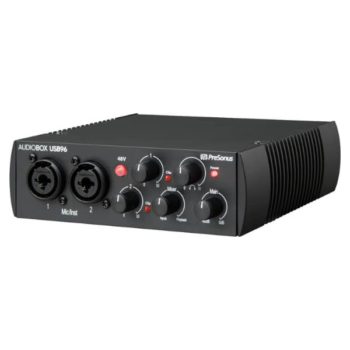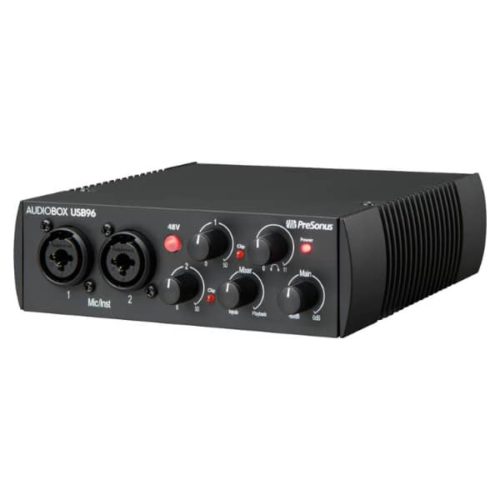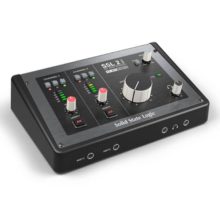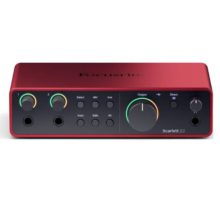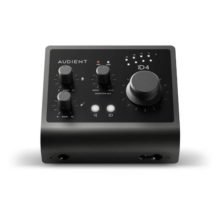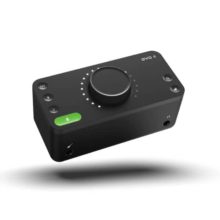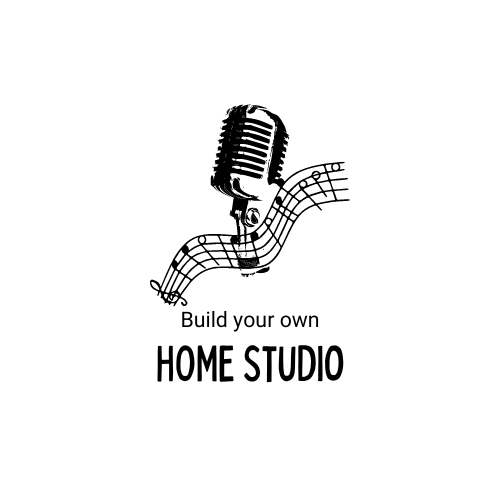The PreSonus AudioBox USB 96 has established itself as a cornerstone of budget home recording for nearly a decade. Priced at around ₹10,000 in India, it sits in the sweet spot between ultra-budget interfaces and professional-grade equipment, making it particularly attractive for singer-songwriters and small bands looking to create quality recordings without breaking the bank.
Build Quality and Design
Physical Construction
The AudioBox USB 96 impresses with its all-metal chassis construction, giving it a professional feel that belies its budget positioning. At 1.4 lbs (0.64 kg), it’s substantial enough to stay put when cables are connected, yet portable enough for mobile recording.
Control Layout
PreSonus has opted for a logical, musician-friendly layout. The front panel features dual combo XLR/TRS inputs with independent gain controls, clip LEDs for each channel, a crucial mixer knob for zero-latency monitoring, and separate volume controls for headphones and main outputs.
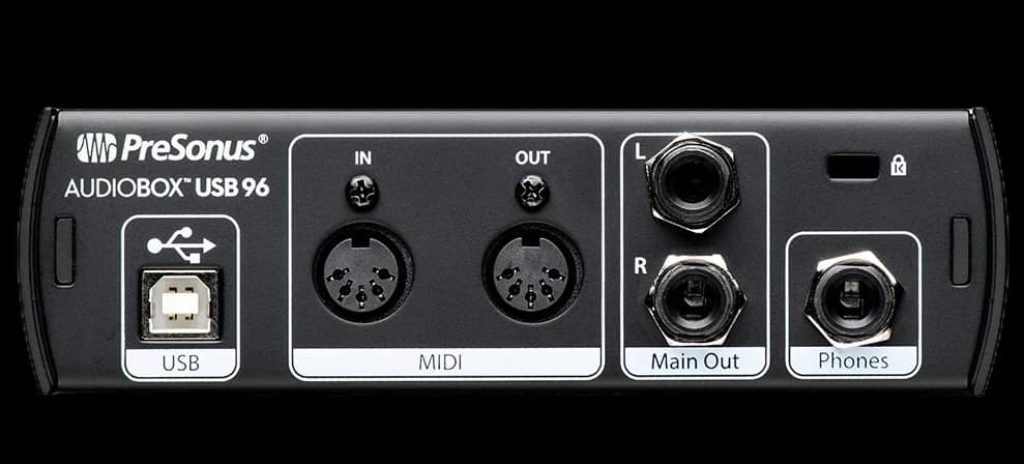
Design Philosophy
Unlike some competitors that prioritize flashy aesthetics, the AudioBox embraces a utilitarian approach. Every control serves a practical purpose, making it intuitive even for beginners.
Technical Specifications Deep Dive
Core Performance
- 24-bit/96kHz recording capability
- Class-A microphone preamps with 0-35dB gain range
- 105dB ADC/DAC dynamic range
- 95dB signal-to-noise ratio on preamps
- USB 2.0 bus-powered operation
The MIDI Advantage: One of the AudioBox’s standout features is its 5-pin MIDI I/O, increasingly rare in this price segment. This allows direct connection of older synthesizers, drum machines, and controllers without requiring USB connectivity.
Audio Performance Analysis
Recording Quality
Microphone Preamps: The Class-A preamps deliver surprisingly clean recordings. Independent testing shows they can handle everything from dynamic microphones to high-end condensers with minimal coloration.
Gain Staging: With 52dB of available gain, the preamps handle most microphones adequately, though quiet mics like the Shure SM7B may require additional gain boosting. The clip LEDs provide crucial visual feedback for proper level setting.
Noise Floor Considerations: While the AudioBox performs well overall, users report that pushing the preamps to maximum gain introduces noticeable noise. This is normal for bus-powered interfaces but requires careful gain staging.
Monitoring Capabilities
Zero-Latency Direct Monitoring: The mixer knob is genuinely useful, allowing seamless blending between direct input signal and DAW playback. This feature alone sets it apart from many competitors.
Headphone Amplifier: The headphone section provides adequate power for most consumer headphones, though it won’t satisfy users with high-impedance professional models.
Output Quality: The balanced TRS main outputs deliver clean signals to studio monitors with minimal noise interference.
Real-World Usage Scenarios
Singer-Songwriters ⭐⭐⭐⭐⭐
Perfect application. Dual inputs allow simultaneous recording of vocals and acoustic guitar, while MIDI connectivity enables keyboard integration. The mixer knob makes overdubbing effortless.
Small Bands ⭐⭐⭐⭐
Excellent for basic band recordings. Two inputs handle guitar and bass, or vocals and instruments. The robust build quality survives band practice environments.
Podcasting/Streaming ⭐⭐⭐⭐
Very capable for spoken word content. Clean preamps, reliable operation, and the ability to connect both host and guest mics make it podcaster-friendly.
Electronic Music Production ⭐⭐⭐⭐⭐
MIDI I/O makes this exceptional value for electronic musicians. Direct connection to vintage synthesizers and drum machines without USB conversion.
Professional Music Production ⭐⭐⭐
Serviceable but limited. The 96kHz maximum sample rate and two-input restriction eventually become bottlenecks for serious productions.
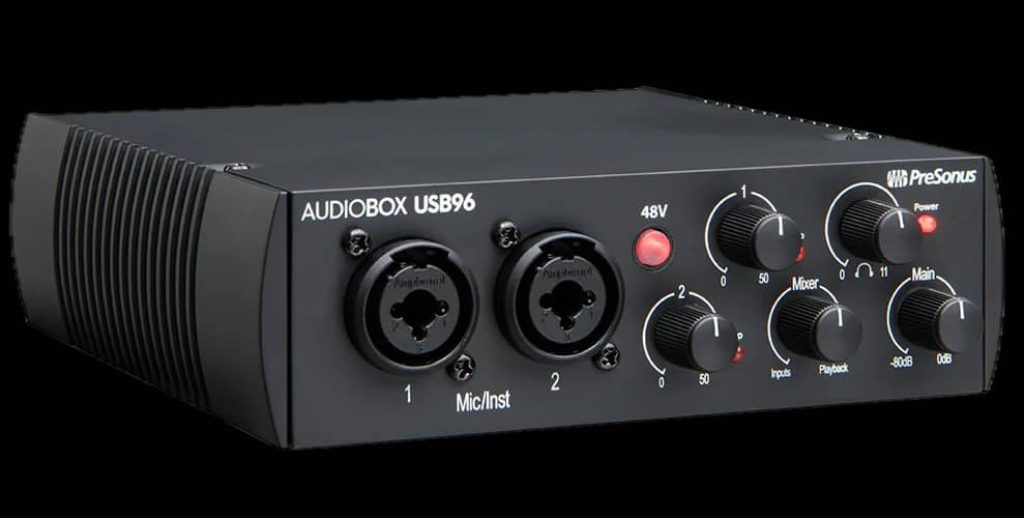
Critical Issues and Limitations
Driver and Compatibility Problems
Windows USB Port Sensitivity: Multiple users report the AudioBox only works with specific USB ports, often requiring USB 2.0 connections rather than 3.0. Some desktop motherboards prove completely incompatible.
Random Audio Dropouts: A persistent issue where audio randomly cuts out, requiring unplugging and reconnecting the device. This appears to be related to Windows power management and USB controller drivers.
Universal Control Dependencies: The PreSonus Universal Control software can be buggy and cause system instabilities. Some users report better results using Windows’ built-in USB 2.0 audio drivers.
Hardware Reliability Concerns
Input Failure Issues: Multiple user reports indicate individual inputs can fail after 6-12 months of use, with Input 1 being particularly susceptible. This appears to be a design flaw rather than abuse-related.
Build Quality Inconsistencies: While generally solid, some units exhibit wobbly control knobs and loose-feeling construction, suggesting quality control variations.
Noise Floor and Signal Quality
Phantom Power Noise: Users report white noise issues when +48V phantom power is engaged, particularly problematic for condenser microphone recording.
Environmental Sensitivity: The AudioBox picks up electrical interference more readily than premium interfaces, requiring careful positioning away from computers and power supplies.
Comparison with Key Competitors
vs. Focusrite Scarlett 2i2:
- AudioBox advantages: MIDI I/O, mix knob, lower price
- Scarlett advantages: Better driver stability, higher sample rates (192kHz), superior build quality consistency
- Verdict: AudioBox wins for electronic musicians; Scarlett for pure recording applications
vs. Behringer UMC22:
- AudioBox advantages: Dual inputs, MIDI, better build quality, dedicated drivers
- UMC22 advantages: Lower price, MIDAS preamps, more compact
- Verdict: AudioBox worth the premium for serious recording
vs. Audient EVO 4:
- AudioBox advantages: MIDI connectivity, traditional controls, proven track record
- EVO 4 advantages: SmartGain automation, better preamps, modern design
- Verdict: EVO 4 for modern workflow; AudioBox for traditional approach
Setup and Usage Tips for Indian Users
Avoiding Common Problems
- Use dedicated USB 2.0 ports on desktop rear panels, never front USB hubs
- Install drivers before connecting the interface
- Stick to the same USB port once drivers are installed
- Disable USB power management in Windows Device Manager
- Keep gain levels moderate to avoid noise floor issues
Optimizing for Indian Electrical Environment
- Use a quality USB cable (included one may pick up interference)
- Position away from computer fans and power supplies
- Consider a USB isolator if experiencing ground loop noise
- Use balanced TRS cables for monitor connections to reduce interference
PreSonus AudioBox USB 96 performance rating
Final Verdict and Recommendations
Highly Recommended For
- Singer-songwriters needing vocals + instrument recording capability
- Electronic musicians requiring MIDI connectivity for hardware synthesizers
- Small bands recording basic tracks
- Podcasters needing dual-microphone capability
- Budget-conscious users wanting professional features without premium pricing
Consider Alternatives If
- You need rock-solid driver reliability for professional work
- Single-input recording meets your needs (consider Audient EVO 4)
- You require higher sample rates (192kHz) for audiophile applications
- Modern features like SmartGain or USB-C connectivity are priorities
- You’re prone to heavy daily use (input reliability concerns)
Bottom Line
The AudioBox USB 96 delivers on its core promise of affordable, feature-rich recording. While it has some reliability quirks and limitations, it offers exceptional value for money with features typically found in more expensive interfaces. For Indian home studio builders seeking a proven, versatile interface that won’t limit their creativity, the AudioBox USB 96 remains a smart choice despite newer competition.
The AudioBox USB 96 proves that you don’t need to spend a fortune to make professional-quality recordings – you just need to understand and work within its limitations.

